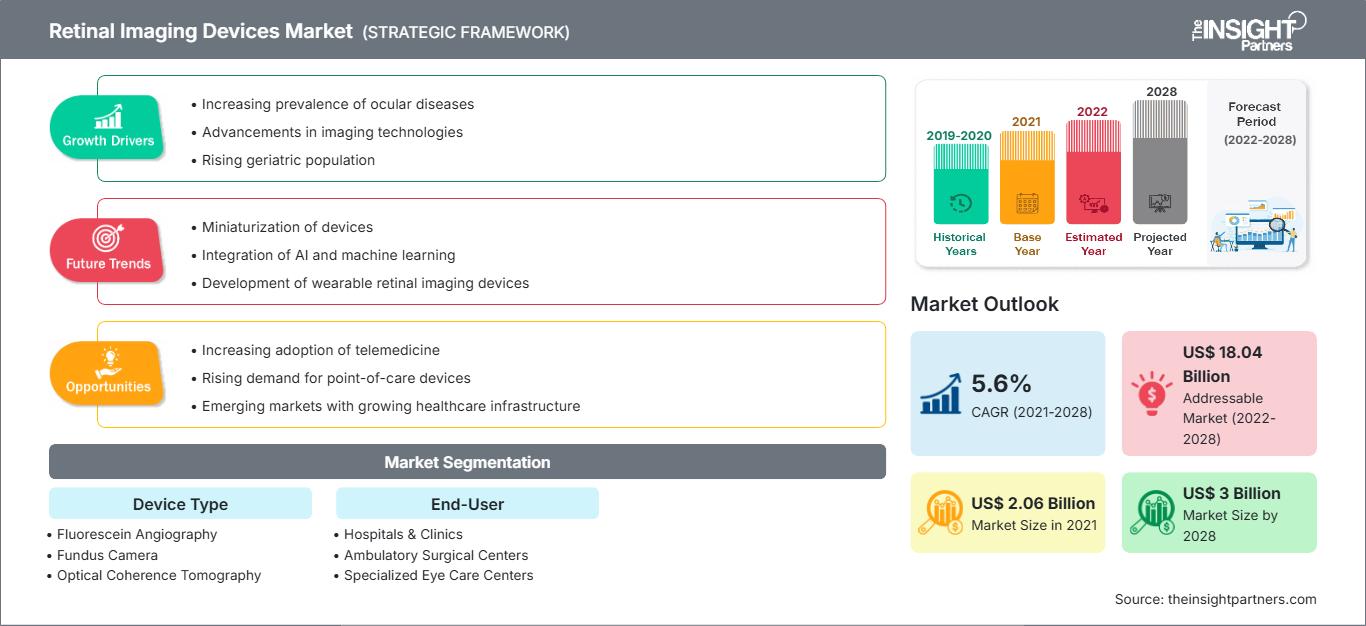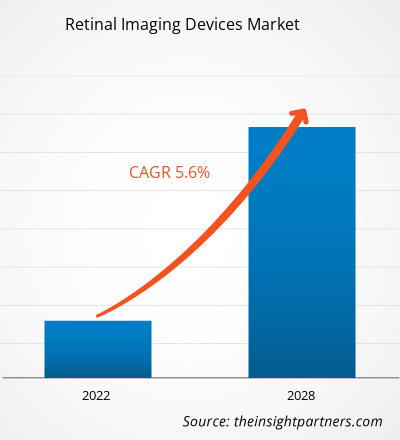Le marché des dispositifs d'imagerie rétinienne devrait atteindre 3 milliards de dollars US d'ici 2028, contre 2,06 milliards de dollars US en 2021 ; sa croissance devrait atteindre un TCAC de 5,6 % entre 2021 et 2028.
L'imagerie rétinienne est une technique utilisée pour analyser et diagnostiquer l'état de la rétine d'un patient. Les dispositifs d'imagerie rétinienne (RID) utilisent des systèmes d'imagerie haute résolution pour capturer des images de l'intérieur de l'œil. L'image capturée permet aux médecins du réseau privé virtuel (VSP) d'évaluer l'état de la rétine, ce qui facilite la détection et la prise en charge de maladies oculaires et de santé telles que le diabète, le glaucome et la dégénérescence maculaire, entre autres.
Personnalisez ce rapport en fonction de vos besoins
Vous bénéficierez d’une personnalisation sur n’importe quel rapport - gratuitement - y compris des parties de ce rapport, ou une analyse au niveau du pays, un pack de données Excel, ainsi que de profiter d’offres exceptionnelles et de réductions pour les start-ups et les universités
Marché des dispositifs d'imagerie rétinienne: Perspectives stratégiques

-
Obtenez les principales tendances clés du marché de ce rapport.Cet échantillon GRATUIT comprendra une analyse de données, allant des tendances du marché aux estimations et prévisions.
La croissance du marché des appareils d'imagerie rétinienne est attribuée à l'amélioration de l'accès des ophtalmologistes à la rétine, à la multiplication des initiatives mondiales contre la cécité et aux avancées technologiques. Cependant, le coût élevé des appareils OCT freine la croissance du marché.
Aperçu du marché : Prévalence croissante des maladies oculaires
Les appareils d'imagerie rétinienne sont largement utilisés pour diagnostiquer et traiter diverses maladies oculaires telles que la rétinopathie diabétique, la dégénérescence maculaire liée à l'âge, le glaucome, le mélanome oculaire et les problèmes de vision légers. De plus, partout dans le monde, la préoccupation concernant la cécité ou les déficiences visuelles augmente considérablement. Selon les données publiées par l'Organisation mondiale de la santé (OMS) en octobre 2021, près de 2,2 milliards de personnes vivent avec une déficience visuelle ou la cécité. Parmi elles, environ un milliard de cas de déficience visuelle peuvent être évités par un diagnostic et un traitement appropriés. Ce milliard de personnes présentent différents problèmes oculaires liés à une déficience visuelle de loin modérée ou sévère ou à la cécité. Les technologies de diagnostic par imagerie ont commencé à offrir une croissance sans précédent dans le domaine des maladies oculaires, grâce à des ensembles de données morphologiques. Ce facteur devrait favoriser le marché des dispositifs d'imagerie rétinienne au cours de la période de prévision.
Informations basées sur le type d'appareil
En fonction du type d'appareil, le marché mondial des dispositifs d'imagerie rétinienne a été segmenté en angiographie à la fluorescéine, caméra de fond d'œil et tomographie par cohérence optique. Le segment de la caméra de fond d'œil détenait la plus grande part de marché en 2021. La photographie du fond d'œil est passée des flashs électroniques aux appareils photo pour smartphone, puis à un kit d'examen oculaire portable plus récent (PEEK). PEEK est une application pour smartphone permettant un examen oculaire complet. L'avantage de ces appareils photo est qu'un non-ophtalmologiste peut prendre des photos et, avec une certaine formation, les évaluer. Cependant, le segment de la tomographie par cohérence optique devrait enregistrer le TCAC le plus élevé du marché, soit 8,1 % au cours de la période de prévision. La tomographie par cohérence optique permet d'évaluer différents niveaux d'ischémie maculaire non diagnostiqués en imagerie primaire. Cette technique est utilisée comme norme pour les modalités d'imagerie oculaire.
Informations basées sur l'utilisateur final
Le marché mondial des dispositifs d'imagerie rétinienne est segmenté en fonction de l'utilisateur final : hôpitaux et cliniques, cliniques spécialisées, centres de soins ambulatoires, etc. Le segment des hôpitaux et cliniques détenait la plus grande part de marché en 2021, et les centres de soins oculaires spécialisés devraient enregistrer le TCAC le plus élevé, soit 6,6 %, au cours de la période de prévision.
Marché des dispositifs d'imagerie rétinienneLes tendances régionales et les facteurs influençant le marché des dispositifs d'imagerie rétinienne tout au long de la période de prévision ont été analysés en détail par les analystes de The Insight Partners. Cette section aborde également les segments et la répartition géographique du marché des dispositifs d'imagerie rétinienne en Amérique du Nord, en Europe, en Asie-Pacifique, au Moyen-Orient et en Afrique, ainsi qu'en Amérique du Sud et en Amérique centrale.
Portée du rapport sur le marché des dispositifs d'imagerie rétinienne| Attribut de rapport | Détails |
|---|---|
| Taille du marché en 2021 | US$ 2.06 Billion |
| Taille du marché par 2028 | US$ 3 Billion |
| TCAC mondial (2021 - 2028) | 5.6% |
| Données historiques | 2019-2020 |
| Période de prévision | 2022-2028 |
| Segments couverts |
By Type d'appareil
|
| Régions et pays couverts |
Amérique du Nord
|
| Leaders du marché et profils d'entreprises clés |
|
Densité des acteurs du marché des dispositifs d'imagerie rétinienne : comprendre son impact sur la dynamique commerciale
Le marché des dispositifs d'imagerie rétinienne connaît une croissance rapide, portée par une demande croissante des utilisateurs finaux, due à des facteurs tels que l'évolution des préférences des consommateurs, les avancées technologiques et une meilleure connaissance des avantages du produit. Face à cette demande croissante, les entreprises élargissent leur offre, innovent pour répondre aux besoins des consommateurs et capitalisent sur les nouvelles tendances, ce qui alimente la croissance du marché.
- Obtenez le Marché des dispositifs d'imagerie rétinienne Aperçu des principaux acteurs clés
Informations régionales
Par région, l'Amérique du Nord a représenté la plus grande part en 2021 et devrait suivre une tendance similaire au cours de la période de prévision. La région Asie-Pacifique devrait connaître le taux de croissance le plus élevé au cours de la période de prévision. L'application de l'intelligence artificielle (IA) et des systèmes d'apprentissage profond (DLS) pour améliorer la couverture de dépistage à Singapour devrait soutenir la croissance régionale au cours des sept prochaines années.
Le lancement et l'approbation de produits sont des stratégies couramment adoptées par les entreprises pour étendre leur présence mondiale et leurs portefeuilles de produits. De plus, les acteurs du marché des dispositifs d'imagerie rétinienne se concentrent sur la stratégie de partenariat pour élargir leur clientèle, ce qui leur permet de maintenir leur marque à travers le monde.
En fonction du type d'appareil, le marché des dispositifs d'imagerie rétinienne est classé en angiographie à la fluorescéine, caméra du fond d'œil et tomographie par cohérence optique. En fonction de l'utilisateur final, le marché est segmenté en hôpitaux et cliniques, centres de chirurgie ambulatoire, centres de soins ophtalmologiques spécialisés et autres utilisateurs finaux. Géographiquement, le marché des appareils d'imagerie rétinienne est segmenté en Amérique du Nord (États-Unis, Canada et Mexique), Europe (Royaume-Uni, Allemagne, France, Italie, Espagne et reste de l'Europe), Asie-Pacifique (Chine, Japon, Inde, Australie, Corée du Sud et reste de l'Asie-Pacifique), Moyen-Orient et Afrique (Émirats arabes unis, Arabie saoudite, Afrique du Sud et reste du Moyen-Orient et de l'Afrique), et Amérique du Sud et centrale (Brésil, Argentine et reste de l'Amérique du Sud et centrale).
Parmi les entreprises répertoriées dans notre champ d'étude, on trouve Carl Zeiss Meditec, Revenio Group Oyj, Nikon Corporation, Optomed, Topcon Corporation, Imagine Eyes, Epipole Ltd, Forus Health Pvt Ltd, Eyenuk Inc et Phoenix Technology Group LLC, entre autres.- Analyse historique (2 ans), année de base, prévision (7 ans) avec TCAC
- Analyse PEST et SWOT
- Taille du marché Valeur / Volume - Mondial, Régional, Pays
- Industrie et paysage concurrentiel
- Ensemble de données Excel
Rapports récents
Témoignages
Raison d'acheter
- Prise de décision éclairée
- Compréhension de la dynamique du marché
- Analyse concurrentielle
- Connaissances clients
- Prévisions de marché
- Atténuation des risques
- Planification stratégique
- Justification des investissements
- Identification des marchés émergents
- Amélioration des stratégies marketing
- Amélioration de l'efficacité opérationnelle
- Alignement sur les tendances réglementaires






















 Obtenez un échantillon gratuit pour - Marché des dispositifs d'imagerie rétinienne
Obtenez un échantillon gratuit pour - Marché des dispositifs d'imagerie rétinienne